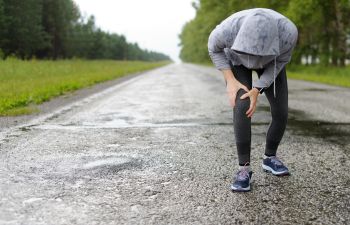
Baker’s cyst, also known as a popliteal cyst, is a buildup of synovial joint fluid behind the knee. The condition can be caused by injuries or other conditions, such as arthritis. The level of pain and the severity of other symptoms vary depending on the underlying cause. In most cases, the underlying cause can be treated, but in severe cases, surgery may be considered.
Causes of Baker’s Cyst
- Arthritis (osteoarthritis, inflammatory or rheumatoid).
- Physical injury, such as a meniscus tear, ligament tear or cartilage tear.Gout
- Inflammation
Symptoms of Baker’s Cyst
When the knee joint is damaged, it can stimulate synovial joint fluid to protect and lubricate the joint. This fluid can build up in a lump or sac at the back of the knee. This is known as a popliteal cyst, or a Baker’s cyst.
Symptoms can vary from person to person, with some people experiencing no pain at all. However, many will experience pain in the knee and the calf, the pain can sometimes be sharp. Visibly you will likely notice a bulge behind the knee. Swelling and pain can also occur in the calf. You may also have difficulty walking, especially walking up stairs, which can create more pain. The knee joint can feel tight or stiff. There may also be locking or catching in the knee joint and difficulty extending or bending the knee.
Pain and swelling in the lower leg could be symptoms of a blood clot, which could be an emergency situation. If you are unsure, have a healthcare provider determine whether it is a Baker’s cyst or a blood clot as soon as possible.
Diagnosis and Treatments of Baker’s Cyst
You will first need to undergo a medical examination to determine the underlying cause of the fluid buildup. The healthcare professional will go over your medical history and you may also have an X-ray scan, an MRI scan and an ultrasound scan. These scans can determine the underlying causes of the Baker’s cyst. An ultrasound scan can also determine if the buildup is fluid or solid.
Nonsurgical treatments are usually suggested first and there are things you can do at home that can improve your symptoms. A common home treatment option is called the RICE method, this includes:
- Resting your leg
- Applying Ice to the knee
- Using Compression wraps on the knee to reduce swelling
- Elevating the knee while resting
Other nonsurgical treatment options include:
- Anti-inflammatory medication
- Corticosteroid injections to reduce inflammation and pain
- Using a crutch or a cane
- Avoiding strenuous activities
- Maintaining a healthy body weight
- Physical therapy to strengthen the knee
If the pain is severe or the range of motion is extremely limited, surgery may be considered. Surgical options include:
- Cyst draining with a needle
- Arthroscopic knee surgery (also known as keyhole surgery)
- Knee Osteotomy (cutting a part of the bone to correct the damage in the knee)
We offer treatments for many types of knee injuries and conditions, including Baker’s cyst. If you suffer from any form of knee pain or knee damage, call Dr. Farzin Kabaei today at (310) 792-9300 or click here to book an appointing with our online form.
Posted on behalf of
8436 West 3rd Street Suite 800
Los Angeles, CA 90048
Phone: (310) 792-9300
Email: fk@docsspineortho.com
Mon - Fri 8AM - 5PM